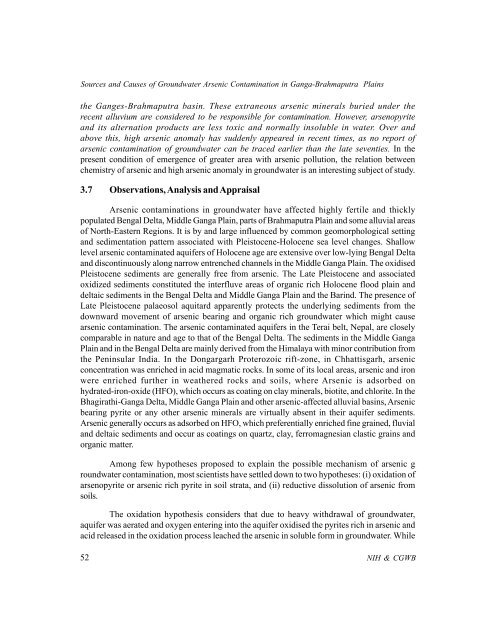Mitigation and Remedy of Groundwater Arsenic Menace in India
Mitigation and Remedy of Groundwater Arsenic Menace in India
Mitigation and Remedy of Groundwater Arsenic Menace in India
You also want an ePaper? Increase the reach of your titles
YUMPU automatically turns print PDFs into web optimized ePapers that Google loves.
Sources <strong>and</strong> Causes <strong>of</strong> <strong>Groundwater</strong> <strong>Arsenic</strong> Contam<strong>in</strong>ation <strong>in</strong> Ganga-Brahmaputra Pla<strong>in</strong>sthe Ganges-Brahmaputra bas<strong>in</strong>. These extraneous arsenic m<strong>in</strong>erals buried under therecent alluvium are considered to be responsible for contam<strong>in</strong>ation. However, arsenopyrite<strong>and</strong> its alternation products are less toxic <strong>and</strong> normally <strong>in</strong>soluble <strong>in</strong> water. Over <strong>and</strong>above this, high arsenic anomaly has suddenly appeared <strong>in</strong> recent times, as no report <strong>of</strong>arsenic contam<strong>in</strong>ation <strong>of</strong> groundwater can be traced earlier than the late seventies. In thepresent condition <strong>of</strong> emergence <strong>of</strong> greater area with arsenic pollution, the relation betweenchemistry <strong>of</strong> arsenic <strong>and</strong> high arsenic anomaly <strong>in</strong> groundwater is an <strong>in</strong>terest<strong>in</strong>g subject <strong>of</strong> study.3.7 Observations, Analysis <strong>and</strong> Appraisal<strong>Arsenic</strong> contam<strong>in</strong>ations <strong>in</strong> groundwater have affected highly fertile <strong>and</strong> thicklypopulated Bengal Delta, Middle Ganga Pla<strong>in</strong>, parts <strong>of</strong> Brahmaputra Pla<strong>in</strong> <strong>and</strong> some alluvial areas<strong>of</strong> North-Eastern Regions. It is by <strong>and</strong> large <strong>in</strong>fluenced by common geomorphological sett<strong>in</strong>g<strong>and</strong> sedimentation pattern associated with Pleistocene-Holocene sea level changes. Shallowlevel arsenic contam<strong>in</strong>ated aquifers <strong>of</strong> Holocene age are extensive over low-ly<strong>in</strong>g Bengal Delta<strong>and</strong> discont<strong>in</strong>uously along narrow entrenched channels <strong>in</strong> the Middle Ganga Pla<strong>in</strong>. The oxidisedPleistocene sediments are generally free from arsenic. The Late Pleistocene <strong>and</strong> associatedoxidized sediments constituted the <strong>in</strong>terfluve areas <strong>of</strong> organic rich Holocene flood pla<strong>in</strong> <strong>and</strong>deltaic sediments <strong>in</strong> the Bengal Delta <strong>and</strong> Middle Ganga Pla<strong>in</strong> <strong>and</strong> the Bar<strong>in</strong>d. The presence <strong>of</strong>Late Pleistocene palaeosol aquitard apparently protects the underly<strong>in</strong>g sediments from thedownward movement <strong>of</strong> arsenic bear<strong>in</strong>g <strong>and</strong> organic rich groundwater which might causearsenic contam<strong>in</strong>ation. The arsenic contam<strong>in</strong>ated aquifers <strong>in</strong> the Terai belt, Nepal, are closelycomparable <strong>in</strong> nature <strong>and</strong> age to that <strong>of</strong> the Bengal Delta. The sediments <strong>in</strong> the Middle GangaPla<strong>in</strong> <strong>and</strong> <strong>in</strong> the Bengal Delta are ma<strong>in</strong>ly derived from the Himalaya with m<strong>in</strong>or contribution fromthe Pen<strong>in</strong>sular <strong>India</strong>. In the Dongargarh Proterozoic rift-zone, <strong>in</strong> Chhattisgarh, arsenicconcentration was enriched <strong>in</strong> acid magmatic rocks. In some <strong>of</strong> its local areas, arsenic <strong>and</strong> ironwere enriched further <strong>in</strong> weathered rocks <strong>and</strong> soils, where <strong>Arsenic</strong> is adsorbed onhydrated-iron-oxide (HFO), which occurs as coat<strong>in</strong>g on clay m<strong>in</strong>erals, biotite, <strong>and</strong> chlorite. In theBhagirathi-Ganga Delta, Middle Ganga Pla<strong>in</strong> <strong>and</strong> other arsenic-affected alluvial bas<strong>in</strong>s, <strong>Arsenic</strong>bear<strong>in</strong>g pyrite or any other arsenic m<strong>in</strong>erals are virtually absent <strong>in</strong> their aquifer sediments.<strong>Arsenic</strong> generally occurs as adsorbed on HFO, which preferentially enriched f<strong>in</strong>e gra<strong>in</strong>ed, fluvial<strong>and</strong> deltaic sediments <strong>and</strong> occur as coat<strong>in</strong>gs on quartz, clay, ferromagnesian clastic gra<strong>in</strong>s <strong>and</strong>organic matter.Among few hypotheses proposed to expla<strong>in</strong> the possible mechanism <strong>of</strong> arsenic groundwater contam<strong>in</strong>ation, most scientists have settled down to two hypotheses: (i) oxidation <strong>of</strong>arsenopyrite or arsenic rich pyrite <strong>in</strong> soil strata, <strong>and</strong> (ii) reductive dissolution <strong>of</strong> arsenic fromsoils.The oxidation hypothesis considers that due to heavy withdrawal <strong>of</strong> groundwater,aquifer was aerated <strong>and</strong> oxygen enter<strong>in</strong>g <strong>in</strong>to the aquifer oxidised the pyrites rich <strong>in</strong> arsenic <strong>and</strong>acid released <strong>in</strong> the oxidation process leached the arsenic <strong>in</strong> soluble form <strong>in</strong> groundwater. While52NIH & CGWB




